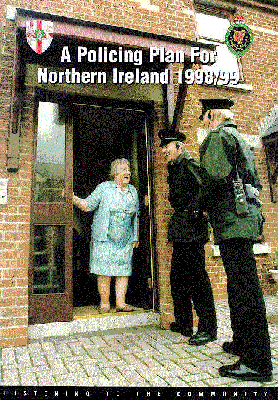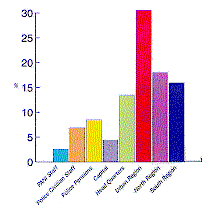A Policing Plan for Northern Ireland 1998/99
[Key_Events] [Key_Issues] [Conflict_Background] Material is added to this site on a regular basis - information on this page may change
NORTHERN IRELAND 1998/99
Contents:What is a Policing Plan? 
Table 1: Objectives and Performance Monitoring established
Table 2: Local Objectives and Performance Monitoring established
Issued by the Police Authority, a Policing Plan is a clear public statement of yearly objectives and measurable targets for the delivery of a quality police service within Northern Ireland. It also forms part of the overall strategic planning process used by the police service. Prepared by the Chief Constable, this Plan is agreed by the Police Authority, based on its consultation with the local community about their policing needs and is endorsed by the Secretary of State. The plan gives the public information about the overall level of police resources and how they will be used throughout the year.
A key aim of a Policing Plan is to provide a real and meaningful
opportunity for people to influence the way their police service
is delivered. Annual Policing Plans have been operating in England and Wales for three years and are proving successful in giving communities a say in the running of their police service. They are now being introduced in Northern Ireland, ahead of legislation, because the Police, the Police Authority and the Government believe the local community must have a direct input into how the police service is developed, delivered and monitored. The policing of Northern Ireland requires this partnership between the police and the community they serve.
The Authority's role is to establish and secure the maintenance
of an effective and efficient police force, while the Chief Constable's
job is to direct and control its operations. As well as being
a key element in setting the style of policing, the new Policing
Plan further increases the accountability of both these organisations
to the community they serve. You have the right to expect the highest possible standards from your police service. The Policing Plan provides a realistic undertaking by the police to meet public expectations within available resources and sets out clear performance indicators to allow you to assess its effectiveness.
The Police are committed to providing a quality service. That
is why all police activity is subject to a clear Statement of
Purpose and Values contained in the Royal Ulster Constabulary's
Charter.
The Police Authority consulted directly with the community to
find out what people wanted and to identify their policing priorities.
Before agreeing this Policing Plan the Authority carried out public
opinion surveys, research with the Community & Police Liaison
Committees and discussion with a wide range of people and organisations
throughout Northern Ireland.
As a result of these widespread consultations, the Authority has
concluded that the following policing priorities need to be addressed:
reducing crime; building confidence in the Police; tackling behaviour
which is threatening, intimidating and anti-social; improving
the service delivery of the Police by reassuring the public through
visible police patrols and ensuring a prompt response to emergency
calls; improving organisational effectiveness. What is meant by policing objectives? Introduced this year by the Police Authority, prepared by the Chief Constable and endorsed by the Secretary of State, this Policing Plan contains objectives which are a set of measurable policing aims. Set by the Police Authority and the Secretary of State, and agreed with the Chief Constable, these objectives reflect community needs and concerns. Reviewed annually, policing objectives are intended to represent a long term approach to policing and will give the community a real opportunity to ensure that its police deliver the type of service it needs.
In addition, area Police Commanders will consult and identify
specific issues on which they will focus and work with local people.
These local priorities are available to the public and enable
a working partnership on the ground between police officers and
individual communities. How will I know if the police really do what is in this Plan? The Police Authority will monitor the performance of the Police against the objectives and measures stipulated in the Plan. Targets have been set by taking into account previous achievements and local policing conditions and the results will be analysed and made public. In this way you will be given a clear assessment of how well the Police achieve their objectives and provide value for money each year.
The emphasis and importance given to each objective must reflect
the needs and demands of the whole community. The Plan must be
sufficiently flexible to cope with any exceptional pressures.
The police service does not operate in isolation from the community - it is an integral part of it. In order to be truly effective, it needs the co-operation of the community, local government, voluntary agencies, local organisations, businesses, etc. A safer society depends upon the community and the police working together for the good of all, particularly those most vulnerable. You have a key role to play in ensuring your opinions on local policing are taken into account and this can be achieved by contributing views to your local Community and Police Liaison Committee.
established by the Secretary of State for 1998/99
established by the Police Authority for Northern Ireland 1998/99
The Secretary of State has established a grant for policing in the financial year 1998/99 at £657.55 million. While this represents a decrease in real terms on the previous year's grant, it will be kept under constant review.
The following table and bar chart indicates the proposed breakdown
of this budget into the major expenditure areas.
Royal Ulster Constabulary 1998/99
(£657,550,000) 
This planning process is a continuous one and will enhance accountability
through the measurement of police activity. Performance within
targets set by this plan will be monitored and forwarded to the
Police Authority every three months. The Authority will carry
out an in-depth assessment of progress placing the results in
context in terms of the policing circumstances prevailing during
that time in Northern Ireland. At the end of the financial year,
a full report will be produced setting out the achievements of
the Royal Ulster Constabulary against the objectives and targets
established in this plan.
This policing plan requires the support and co-operation of
the whole community Through working together we can improve quality
of life for all and make Northern Ireland a safer place in which
to live. Partnership is the foundation for all aspects of policing
in this country It will continue to be central in the relationship
between the Royal Ulster Constabulary and the Police Authority
for Northern Ireland to ensure the provision of an effective police
service far all the people of Northern Ireland.
To provide a high quality, effective police service to all the
people of Northern Ireland. We will work to achieve this in partnership
with the community and in co-operation with other agencies.
We will perform our duty with integrity, common sense and sound judgement and be sensitive to the views of the community in our actions. We will offer assistance to members of the public irrespective of their age, sex, their political or religious beliefs or their ethnic or social background. We will manage our organisation in the most professional manner, seeking the opinions of our staff, promoting equal opportunity for all and showing a willingness to change where such change is necessary.
We will adhere to our code of professional policing ethics. The Police Authority for Northern Ireland aims to secure for the Northern Ireland Community the provision of an impartial, acceptable, effective and efficient police service which is accountable to that community through the Authority.
| ||||||||||||||||||||||||||||||||||||||||||||||||||||||||||||||||||||||||||||||||
CAIN
contains information and source material on the conflict
and politics in Northern Ireland. CAIN is based within Ulster University. |
|
|
|||
|
Last modified :
|
||
|
| ||
